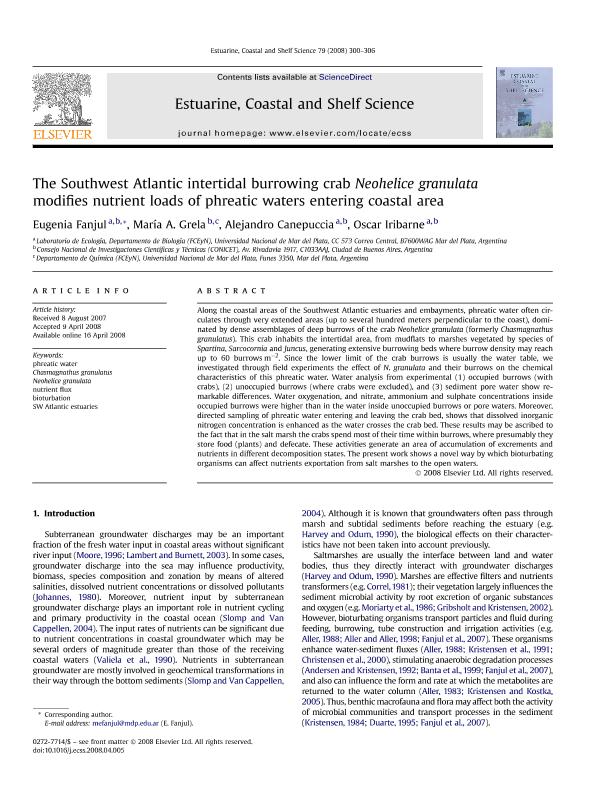Artículo
The Southwest Atlantic intertidal burrowing crab Neohelice granulata modifies nutrient loads of phreatic waters entering coastal area
Fanjul, Maria Eugenia ; Grela, Maria Alejandra
; Grela, Maria Alejandra ; Canepuccia, Alejandro Daniel
; Canepuccia, Alejandro Daniel ; Iribarne, Oscar Osvaldo
; Iribarne, Oscar Osvaldo
 ; Grela, Maria Alejandra
; Grela, Maria Alejandra ; Canepuccia, Alejandro Daniel
; Canepuccia, Alejandro Daniel ; Iribarne, Oscar Osvaldo
; Iribarne, Oscar Osvaldo
Fecha de publicación:
08/2008
Editorial:
Academic Press Ltd - Elsevier Science Ltd
Revista:
Estuarine, Coastal and Shelf Science
ISSN:
0272-7714
Idioma:
Inglés
Tipo de recurso:
Artículo publicado
Clasificación temática:
Resumen
Along the coastal areas of the Southwest Atlantic estuaries and embayments, phreatic water often circulates through very extended areas (up to several hundred meters perpendicular to the coast), dominated by dense assemblages of deep burrows of the crab Neohelice granulata (formerly Chasmagnathus granulatus). This crab inhabits the intertidal area, from mudflats to marshes vegetated by species of Spartina, Sarcocornia and Juncus, generating extensive burrowing beds where burrow density may reach up to 60 burrows m-2. Since the lower limit of the crab burrows is usually the water table, we investigated through field experiments the effect of N. granulata and their burrows on the chemical characteristics of this phreatic water. Water analysis from experimental (1) occupied burrows (with crabs), (2) unoccupied burrows (where crabs were excluded), and (3) sediment pore water show remarkable differences. Water oxygenation, and nitrate, ammonium and sulphate concentrations inside occupied burrows were higher than in the water inside unoccupied burrows or pore waters. Moreover, directed sampling of phreatic water entering and leaving the crab bed, shows that dissolved inorganic nitrogen concentration is enhanced as the water crosses the crab bed. These results may be ascribed to the fact that in the salt marsh the crabs spend most of their time within burrows, where presumably they store food (plants) and defecate. These activities generate an area of accumulation of excrements and nutrients in different decomposition states. The present work shows a novel way by which bioturbating organisms can affect nutrients exportation from salt marshes to the open waters.
Archivos asociados
Licencia
Identificadores
Colecciones
Articulos(CCT - MAR DEL PLATA)
Articulos de CTRO.CIENTIFICO TECNOL.CONICET - MAR DEL PLATA
Articulos de CTRO.CIENTIFICO TECNOL.CONICET - MAR DEL PLATA
Articulos(IIMYC)
Articulos de INSTITUTO DE INVESTIGACIONES MARINAS Y COSTERAS
Articulos de INSTITUTO DE INVESTIGACIONES MARINAS Y COSTERAS
Citación
Fanjul, Maria Eugenia; Grela, Maria Alejandra; Canepuccia, Alejandro Daniel; Iribarne, Oscar Osvaldo; The Southwest Atlantic intertidal burrowing crab Neohelice granulata modifies nutrient loads of phreatic waters entering coastal area; Academic Press Ltd - Elsevier Science Ltd; Estuarine, Coastal and Shelf Science; 79; 2; 8-2008; 300-306
Compartir
Altmétricas



